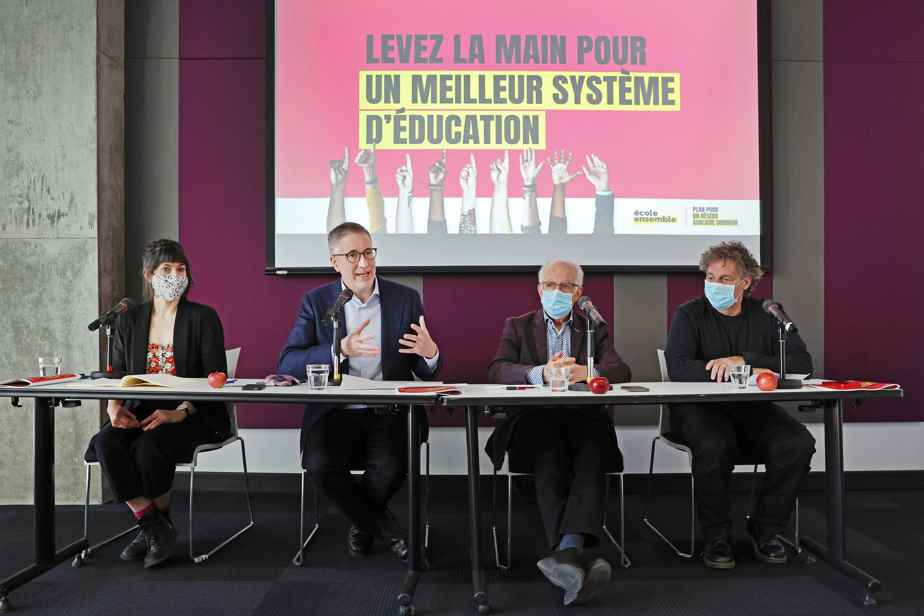The Quebec education system is “unfair” and to reform it, the École ensemble movement proposes to end the funding of private schools and that all students in the province attend their neighborhood school, at primary and secondary level.
Posted at 5:00 a.m.
Five years after its creation by parents, the École ensemble movement is back on the attack a few months before the provincial elections by tabling a plan that aims to fundamentally change the education system.
At the heart of this proposal, unveiled on Monday, is the creation of a single network of schools, where each student would attend the establishment of his district, both in primary and secondary school. This would therefore be the end of subsidized private schools as we know them: private schools would be 100% funded by Quebec and free for all. In a six-year horizon, they should exclusively welcome pupils from their basin.
“Schools no longer choose their students,” summarized in a press briefing Stéphane Vigneault, coordinator of the École ensemble movement. The children go to their school [de quartier]regardless of their parents’ ability to pay,” he continued.

PHOTO ROBERT SKINNER, THE PRESS
Stéphane Vigneault, coordinator of the École ensemble movement
As is the case in Ontario, schools could remain private and select their students, but they would no longer receive public funds, “neither directly (subsidies) nor indirectly (school transport)”, we read in the report of the movement. .
École ensemble commissioned economist François Delorme, from the University of Sherbrooke, who calculated that the annual savings for Quebec would be $100 million.
Beyond the savings, this reorganization would make it possible to get out of an “inefficient and inequitable” system which, currently, “has few winners and many losers”, estimated Claude Lessard, sociologist of education and former president of the Superior Council of Education, which chairs the Board of Directors of École Ensemble.

PHOTO ROBERT SKINNER, THE PRESS
Claude Lessard, Chairman of the Board of Directors of École ensemble
“Research has been telling us for a long time: the more the classes are diversified, between boys and girls, between advantaged and disadvantaged students, between strong and weak students, between students of various ethnic origins, the higher the success rate of all young people increases,” said Mr. Lessard.
For parents who are in the race to choose a secondary school and young people who experience stress at the idea of not being admitted to a chosen program, attending a neighborhood school is a “simple, peaceful vision, which seems unattainable,” observed Anne-Marie Boucher, vice-president of École ensemble. “Yet this is what we are proposing and which is becoming possible,” she added.
Special programs for everyone
The École ensemble movement also wishes to generalize a model already implemented in certain secondary schools in the province, namely that of offering special programs free of charge to all students, without selection on the basis of academic results.
According to data provided to The Press by the Ministry of Education, nearly one in four students (23.6%) who attend public secondary school are enrolled in a particular program in 2020-2021.
The international education program is the most popular, followed by the sports, arts and language programs.
Last week, the Minister of Education, Jean-François Roberge, promised to introduce new measures to make special programs, often expensive, more accessible to all.
“Elastic stretched to the end”
This is not enough: we must also abolish funding for subsidized private schools, believes Stéphane Vigneault.
“The elastic, we stretched it to the end. Social acceptability for schools that select, whether public or private, is no longer there. The population wants a fair system, ”said Mr. Vigneault, who said he hoped that political parties would take up these proposals in the next election campaign.
Parti Québécois MP Véronique Hivon praised “the quality of the proposal” of the École ensemble movement.
“She is truly, and very concretely, advancing the debate on the future of our school system and on equal opportunities, which must be a fundamental pillar of it,” said her party’s spokeswoman for education.
Learn more
-
- 450 405
- Number of secondary school students for the 2020-2021 school year
source: Ministry of Education

